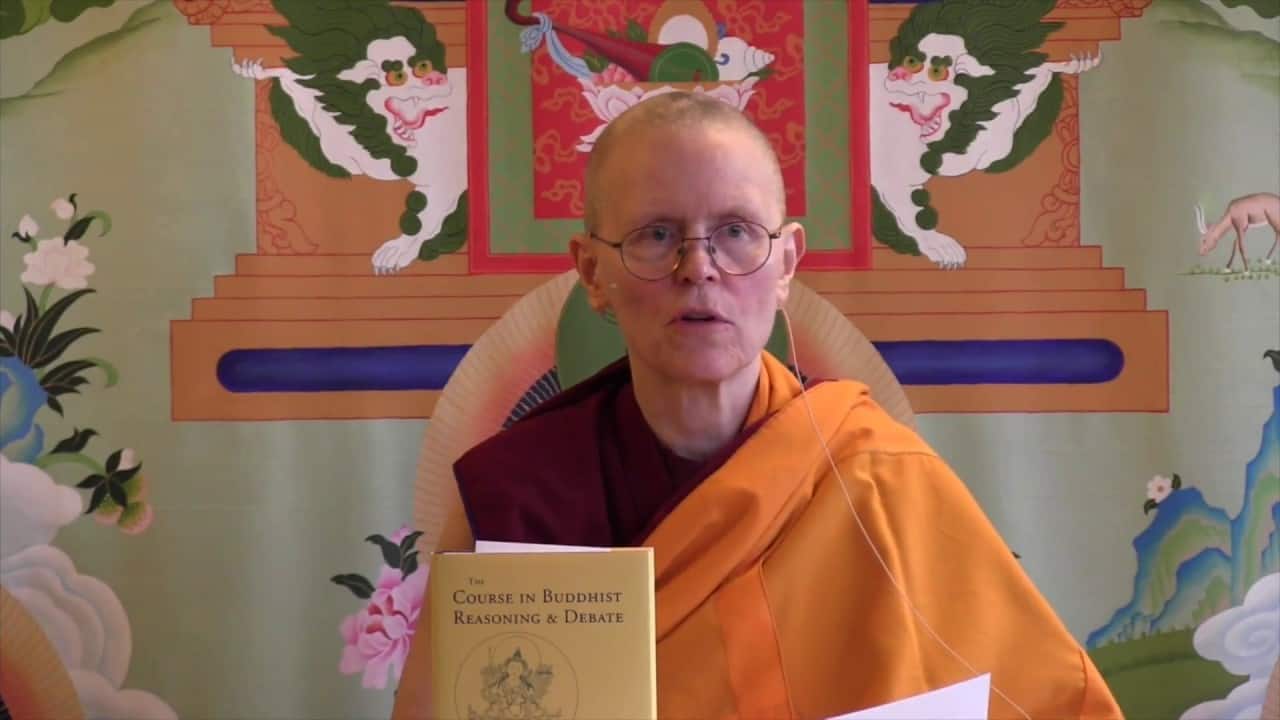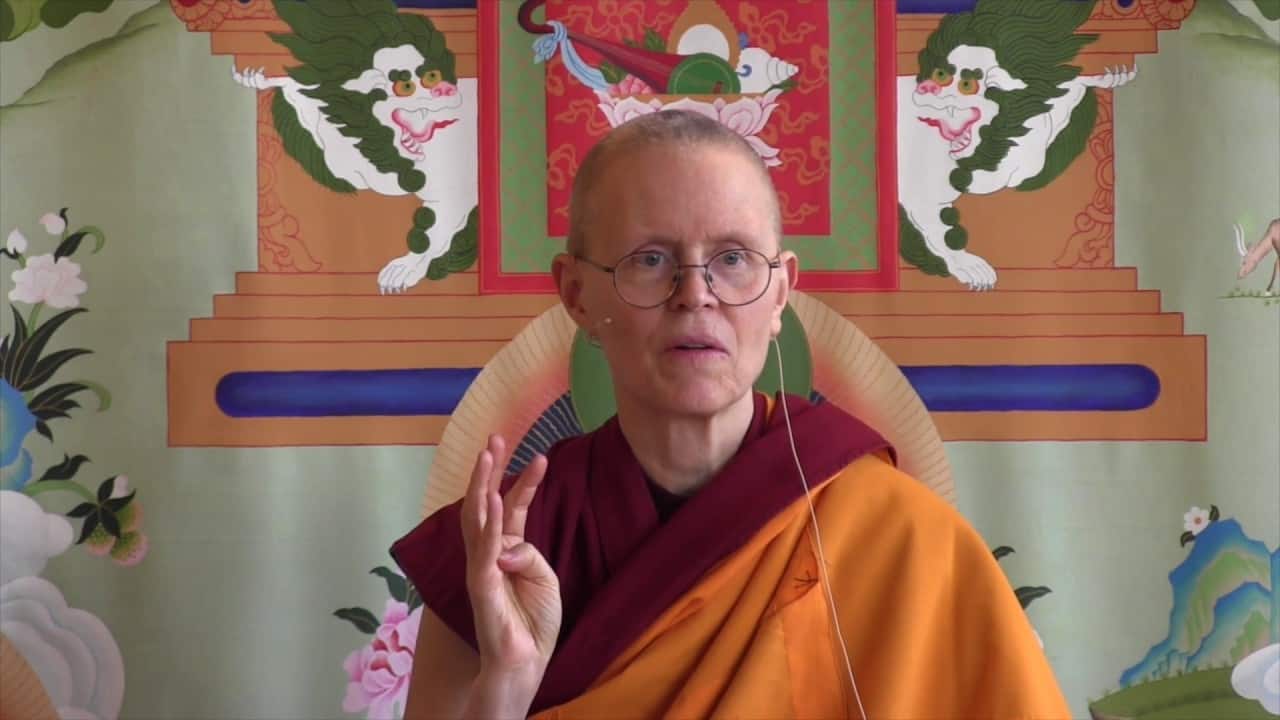Gomchen Lamrim review: Seven-point cause and effect instruction
Part of a series of teachings on the Gomchen Lamrim by Gomchen Ngawang Drakpa. Visit Gomchen Lamrim Study Guide for a full list of contemplation points for the series.
- Meditation to develop equanimity from our own and other’s point of view
- Review of the first three steps in the seven-point cause and effect method
- Meditation on the continuity of our mind and recognizing all beings as our mother
- Meditation on the kindness of our mother of this life
- Ways to repay the kindness of our mothers
Gomchen Lamrim 86 review: Seven-point cause and effect instruction (download)
Contemplation points
Equanimity
- Call to mind a dear friend, someone who is easy to be around, someone whose company you enjoy. Think of someone specific. See their face.
- Think, just as I want happiness (take moment to feel that)
- …just as I want to be free of suffering (take a moment to feel that),
- …the same is true of my dear friend __________. He/She also wants happiness and doesn’t want suffering. Try to feel that this is also true for your dear friend.
- Let’s extend this to someone we think of as a stranger. Someone you see regularly – at the grocery store, in the neighborhood. Think of someone specific.
- Think, just as I want happiness (take moment to feel that),
- …just as I want to be free of suffering (take a moment to feel that),
- …the same is true of this person who appears as a stranger. He/She equally, with the same intensity as I, wants happiness and to be free of suffering. Really feel that as true.
- Likewise, we can extend this to someone we currently find difficult, who pushes our buttons. Think of someone specific. Make an effort to feel their desire for happiness and freedom from suffering.
- Think, just as I want happiness (take moment to feel that),
- …just as I want to be free of suffering (take a moment to feel that),
- …the same is true of this person who I currently find challenging. He/she wants nothing more than happiness and to be free of every kind of suffering. Really feel that this is true.
- Conclusion: This is a powerful mental training that we can do with every waking moment of our lives. Resolve to train your mind to see others in this way.
All beings have been our mother
- Consider: What you are doing with your mind now influences your mind tomorrow and who you will be as a person. There is continuity. Similarly, yesterday’s mind was influenced by the day before. You can trace back and back and understand that each day’s mind is the result of the mind of the previous day. Going back in this way, we come to a strong conclusion that our mind is a continuity, changing moment by moment and each moment influencing the next.
- Now, think back to thoughts and experiences you had a year ago. What were you doing in April 2016? Reflect on how all the thoughts and experiences from then have contributed to the person you are today, based on this continuity of mind.
- Next, think back to your thoughts and experiences from 10 years ago (2007). What were you doing in 2007: All the thoughts and experiences, entertainment and conversations… Get a sense of the continuity of the mind over 10 years and how it influences the body and mind and who you are today.
- If you take a bigger leap, you can think back to your childhood. Again notice the continuity. How did your childhood influence who you are as a person and how you see the world?
- Going back further, science tells us that even in the womb there is conscious experience. All your experience as a fetus and embryo, those have contributed to who you are today.
- If you can imagine, continue to trace back and arrive at the first moment of consciousness. Think of that first moment and reflect on how the consciousness is impermanent and how it requires a previous and compatible cause. That first moment of mind can’t come from sperm and egg (because that is physical and the mind is not), so what we can infer is that that first moment of mind must have had a previous moment of mind from another life in some form. We’d find another first moment of mind connected to some previous life. Spend some time considering this.
- In this way, we can infer (based on logic) that the continuity of the mind is beginningless. We can’t point to any moment of mind as being the first. As we think about this, naturally, we conclude that our mind is beginningless. And if that is so, then our rebirths must also be beginningless. Just as we’ve had beginningless rebirths, we must have had countless mothers to support those rebirths. Spend some time with this.
- Think of the people around you. Imagine that in some life they have been your mother. Allow softening for others to arise in your heart.
- Take time to think about each person in your family. Imagine that in some life they have been your mother. Allow a softening for them to arise in your heart.
- Now think about strangers in your life. Imagine that in some life they have been your mother.
- Finally, think about people you have some difficulty with. Imagine that in some life they have been your mother countless times.
- How might thinking of others in this way change the way you interact with them?
- Conclusion: Resolve to use that awareness of all beings as your mother to inform the way you interact with them throughout the day, living with greater kindness, love, and compassion.
Kindness of our mother
- Reflect on how your mother cared for you in the womb when you were just a mass of cells. Think about it, 9 months is a long time. She fed you with her own flesh and blood for all that time as you developed. She experienced discomfort, embarrassment, and was willing to experience the suffering of childbirth to bring you into the world.
- At birth, you arrived with nothing, but she showered you with unconditional love. You were helpless for months and years and she took care of your every need. She loved and cherished you more than her own self. She kept you clean and dry, safe and warm. Think of how many diapers were changed. She spent countless hours cleaning, feeding, smiling, cooing, teaching you your first words, Chances are good she was there to help you take your first steps. She protected you from so many harms. She made sure you didn’t get sick and cared for you when you needed it. Due to her kindness you are alive. The fact that you can use a fork and spoon, talk, use the toilet, etc is because of her kindness. From your own direct experience, you can see that the kindness of your mother is unparalleled. Reflect on this.
- You could likely make a long list of sacrifices she made for your welfare. Reflect for a moment that she’s done that not just in this life, but in many other lives too.
- Now reflect how the father of this life has also been your mother in past lives and has shown the same magnitude of kindness.
- The same is true of sisters and brothers, dear friends, in fact, every person you meet has been this kind to you when they’ve played the role of your mother in countless rebirths. Take a moment to reflect on this.
- How does thinking in this way change the way you see others? How might it change the way you interact with them?
- Conclusion: When we’ve really thought about these points, a wish to repay their kindness naturally arises. Resolve to use this contemplation to inform the way you view others in your daily life, to repay their great kindness through generosity, kindness, and through developing your own spiritual practice so that you can be of even greater benefit to them in the future.
Venerable Tenzin Tsepal
Venerable Tenzin Tsepal was first introduced to meditation in high school in the 1970s. While working as a dental hygienist in Seattle and hospital administration in Yakima, she practiced and attended retreats in the Vipassana tradition. In 1995, she found Dharma Friendship Foundation and teachings with Venerable Thubten Chodron. She attended the Life As A Western Buddhist Nun conference in India as a lay volunteer in 1996. Following a life-changing 3-month Vajrasattva retreat in 1998, Ven. Tsepal lived in Dharmsala, India for two years where she further explored the idea of monastic life. She received novice ordination as a Buddhist nun with His Holiness the Dalai Lama in March of 2001. After ordination, she was immersed in the full-time residential Buddhist Studies Program at Chenrezig Institute in Queensland, Australia, principally with Khensur Rinpoche and Geshe Tashi Tsering. As a qualified FPMT teacher, Ven. Tsepal was appointed the Western Teacher at Chenrezig Institute from 2004 to 2014, teaching the Discovering Buddhism series, tutoring for the general program and leading retreats. In 2015, she tutored three subjects for the FPMT Basic Program. Venerable Tsepal arrived at Sravasti Abbey in mid-January for the 2016 Winter Retreat. She joined the community in September 2016, and received Shiksamana training that October.


